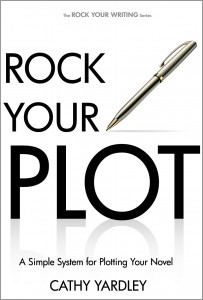 I’ve recently put my first reference book up on Kindle, called Rock Your Plot: A Simple System for Plotting Your Novel. It details the process I use for pre-writing and plotting my novels. It’s a simple, repeatable system for anyone writing any form of commercial genre fiction — mysteries, sci-fi, romance, whatever.
I’ve recently put my first reference book up on Kindle, called Rock Your Plot: A Simple System for Plotting Your Novel. It details the process I use for pre-writing and plotting my novels. It’s a simple, repeatable system for anyone writing any form of commercial genre fiction — mysteries, sci-fi, romance, whatever.
(Needless to say, I love it and am obsessed with it and I think it would help you and please buy it. Ahem.)
I’ve gotten some reader feedback, asking if I could show how the plot points work in some well-known fiction. Which seemed like a good idea, so…
First attempt: fairy tales.
The initial suggestion was that I use kids’ stories, fairy tales, because they tend to be universally known. When I sat down to dissect the story structure, I discovered that fairy tales are actually hard to use as examples.
Why? Because quite often, the protagonist is passive and has no developmental arc.
In plot points as I teach them, your protagonist might start out reactive, but he or she must have a goal — a pressing desire. By the midpoint, the protagonist should have enough gumption to start actively pursuing said goal with a plan of some sort, even if the plan goes horribly wrong. Finally, the protagonist needs to have changed, developed, and learned something from the beginning of the book to the end of the book. While a moral is a key element of the story, generally the protagonist just embodies the moral — he doesn’t necessarily change all that much.
For example, Cinderella wants to go to the ball (external goal) to escape the drudgery of her stepmother. She’s given the opportunity when her fairy godmother provides the means, with a catch: be home by midnight.
Cinderella meets the prince (midpoint, presumably) and is in love and happy… but almost forgets re: midnight (black moment!) and rushes home, loses everything but one slipper, is back in drudgery.
The resolution does not stem from her actions, per se. The prince searches for her with the shoe she left behind (not deliberately — that was just crazy random happenstance as she tried to get the hell out before her dress fell apart) and then finds her.
Huzzah! She’s still the same nice girl and she’s learned… um, to wear shoes that don’t quite fit.
Also, repetition tends to be an important part of fairy tale structure: things happen in cycles of threes, slight variations on the initial goal. It’s a structure that works for fairy tales, but not three act structure. Thee brothers; three rivals; three pigs.
In the three little pigs, the first pig is the laziest and loses his house first — so he runs to the second, who is marginally smarter. (“Dude, sticks are so much sturdier than straw. Duh!”) Repetition: the antagonist strikes again, and they run to the last, smartest, most industrious pig.
Unable to repeat the pattern, the wolf tries a sneak attack. The crafty pigs foil the plan: the wolf is either cooked or sent like a rocket out of the chimney, depending on which version you read.
There isn’t a clear protagonist arc; there aren’t clear plot points. One assumes the pigs will realize that industry is more important than laziness, that smarts trump strength, and that building materials matter. But again, it’s not a classic three-act progression.
Second attempt: Star Wars, Episode IV.
Instead of a fairy tale, I’m going to try using a movie I presume everyone has seen: Star Wars. The original 1977 one, not any subsequent ones.
You have several main characters, but for all intents and purposes, Luke Skywalker is our protagonist, so I’ll chart his plot points.
Inciting Incident. The thing that tips that first domino for Luke is when his Uncle Owen purchases the escaped droids, C-3P0 and R2D2… and R2D2 promptly escapes, searching for Obi-Wan Kenobi. If he had not crossed paths with the droids, he would not have had the means nor the motivation to start on his story arc, or really grow as a character.
Plot Point 1: Luke tries to resist the siren lure of adventure, but when the Imperial Troops kill his aunt and uncle and destroy his home, he’s thrust into his Goal — get R2D2 to Princess Leia/the rebels.
His motivation: to help destroy the empire by stopping this Death Star they’ve got going.
The conflict: he’s a farmboy from Tatooine and really hasn’t faced anything of this magnitude. Also, he’s got no idea how to do any of this. (Thankfully, his mentor has a fairly good game plan.)
Pinch Point 1: The antagonistic force responds in the form of conflict at the Mos Eisley Space Port: Imperial forces, among other things, try to find the droids and stop Luke from leaving the planet on the Millenium Falcon. (Fortunately, these “weren’t the droids they were looking for” and Han shot first.)
Midpoint: They learn that the rebel headquarters they were going to has been blown up — along with the planet around it, ouch. This is the new information that also raises the stakes.
They’re brought on board the Death Star, and they also learn that Princess Leia, the one who kicked off this mission in the first place by putting information in R2D2, is a prisoner.
So in order to achieve the goal (give the information to the rebels/blow up the Death Star) they now have a new game plan: rescue Leia and get out.
Pinch Point 2: The Empire strikes back! (Sorry.) The antagonistic force strikes back, that is, and strikes harder by removing the one thing Luke counts on most. Obi-Wan battles with Darth Vader and dies… consequently, Luke loses his mentor. (Sort of.)
Plot Point 3: Through ingenuity, blasters, an epic space battle, and a whole lotta yelling, they manage to rescue the princess and escape the Death Star and get to the real rebel base to deliver the plans.
Black Moment: The only weakness found on the ginormous Death Star is apparently dropping a bomb down an air conditioning duct.
And by the way, it’s got tons of guns to prevent just such an attempt. That is, if Luke manage to get past all those enemy fighters and spaceships and whatnot.
Oh, and that awesome pilot and buddy of Luke’s, Han Solo? The guy who could totally help? He’s grabbed his cash and he’s out of here.
Luke could always ask his mentor… wait, no. Obi-Wan’s dead.
Oh, and that Death Star? Should be here in about fifteen minutes to blow you guys up.
In short: Things look bad for our heroes.
Resolution: Using the force and an assist from his flaky friend Han, as well as skills and confidence gained from his developmental arc, Luke manages to drop the bomb down the air conditioning duct and blow that mutha up. Huzzah! Farm boy makes good!
This is three-act structure at its most classic.
In under 1000 words — most of them smart-ass, at that — you can see a clear developmental progression of a protagonist as he identifies his goal, overcomes conflict, is crushed by a climax and comes out on the other side in a clear and satisfactory resolution.
This can work for any genre. You can watch the same progression in Pretty Woman, or Silence of the Lambs, or The Hangover. You can see it in almost any popular genre novel.
It’s not a “formula.” It’s a structure. And it’s used, over and over… because it works.
Click here to get even more detail, as well as helpful prompts and examples, in Rock Your Plot book for only $3.99.
